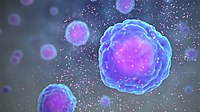
Photo from wikipedia
Sepsis is the leading cause of death among patients, especially elderly patients, in intensive care units worldwide. In this study, we established a sepsis model using naturally aged rats and… Click to show full abstract
Sepsis is the leading cause of death among patients, especially elderly patients, in intensive care units worldwide. In this study, we established a sepsis model using naturally aged rats and injected 5×106 umbilical cord-derived MSCs via the tail vein. Each group of rats was analyzed for survival, examined for biochemical parameters, stained for organ histology, and analyzed for the Th cell subpopulation ratio and inflammatory cytokine levels by flow cytometry. Western blotting was performed to detect the activity of the JAK-STAT signaling pathway. We designed the vitro experiments to confirm the regulatory role of MSCs, and verified the possible mechanism using JAK/STAT inhibitors. It was revealed from the experiments that the 72 h survival rate of sepsis rats treated with MSCs was significantly increased, organ damage and inflammatory infiltration were reduced, the levels of organ damage indicators were decreased, the ratios of Th1/Th2 and Th17/Treg in peripheral blood and spleen were significantly decreased, the levels of pro-inflammatory cytokines such as IL-6 were decreased, the levels of anti-inflammatory cytokines such as IL-10 were increased, and the levels of STAT1 and STAT3 phosphorylation were reduced. These results were validated in in vitro experiments. Therefore, this study confirms that MSCs can control the inflammatory response induced by sepsis by regulating Th cells and inflammatory factors, and that this leads to the reduction of tissue damage, protection of organ functions and ultimately the improvement of survival in aged sepsis model rats. Inhibition of the JAK-STAT signaling pathway was surmised that it may be an important mechanism for their action.
Journal Title: Frontiers in Immunology
Year Published: 2022
Link to full text (if available)
Share on Social Media: Sign Up to like & get
recommendations!